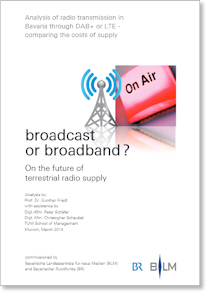
It is frequently, optimistically claimed that the large download capacity provided by the wireless communication standard LTE* will solve all problems for the IP distribution of radio, and maybe even television, services to mobile devices. Such statements represent an oversimplification of what in reality is a complex problem, including various non-technical aspects such as net neutrality, and not in the last place: costs.
|
In November last year, Swedish network provider Teracom published a white paper from research company A-focus , which it had asked to study if celular networks can cope with linear radio broadcasting. The study concluded that "...[replacing the] distribution of radio in the terrestrial broadcast network ... with distribution via cellular networks ... is not credible and that the need for terrestrial broadcasting will remain for an indefinite future." The main (but not only) reason for this was found to be the very high costs of such an approach.
Similar evidence is now available** from research led by Prof. Dr. Gunther Friedl (TUM School of Management) commissioned by the Bayerische Landeszentrale für neue Medien (BLM) and Bayerischer Rundfunks (BR). The study "Analysis of radio transmission in Bavaria through DAB+ or LTE - comparing the costs of supply" finds that "Providing terrestrial radio exclusively via LTE would be around 40 times more costly than transmission via DAB+".
These results make clear it is unrealistlic to base radio distribution on mobile networks alone. The German study concludes that instead the migration from FM to DAB+ should be accelarated in the coming years without excluding the additonal provision of terrestrial radio via LTE, leaving the door open to a hybrid future. |
The EBU project group CTN Mobile expects to soon publish a technical report assessing the delivery of broadcast content over LTE networks. For more information, contact: Darko Ratkaj (EBU) .
* Long Term Evolution, including LTE eMBMS (enhanded Multimedia Broadcast Multicast Service). LTE is commonly marketed as '4G'. *Available in English since June 2014.

